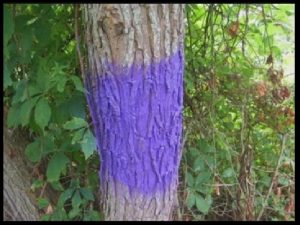I’ve been asked a few times about the meaning of purple bars painted on trees. At a recent class, someone showed me the relevant statute, which led me to learn a little more about it. This post lays out what I know.
Purple paint on trees? If you live in a rural area, you’re probably familiar with the purple paint phenomenon. If you don’t, you might not be. Here’s an example of a tree with a purple bar painted on it:
Legal significance. In North Carolina, it is a Class 2 misdemeanor to hunt, fish, or trap on another’s land if the land has been posted against such activity. G.S. 14-159.6. The posting may be done with signs, but G.S. 14-159.7 allows for another option:
The owner or lessee of the property may place identifying purple paint marks on trees or posts around the area to be posted. Each paint mark shall be a vertical line of at least eight inches in length, and the bottom of the mark shall be no less than three feet nor more than five feet from the base of the tree or post. The paint marks shall be placed no more than 100 yards apart and shall be readily visible to any person approaching the property. For the purpose of prohibiting fishing, or the taking of fish by any means, in any stream, lake, or pond, it shall only be necessary that the paint marks be placed along the stream or shoreline of a pond or lake at intervals of not more than 100 yards apart.
If a person obtains the written permission of the owner or lessee, hunting, fishing, or trapping is allowed to the extent otherwise permitted. Without written permission, it’s prohibited.
Why purple paint? In an online FAQ about the law, the Wildlife Resources Commission explains:
Landowners in North Carolina who want to post their lands can have difficulty keeping posted signs erected and intact. Using paint marks, as an alternative or in addition to signage, is a convenient and effective means of marking lands as posted, and requires less frequent maintenance and cost, since paint marks are more difficult to vandalize than signs.
Doesn’t prohibit trespassing generally. The paint only protects against hunting, fishing, or trapping. It doesn’t prohibit, for example, hiking or birdwatching. A no trespassing sign would be effective against those other activities, of course.
Some other states have a similar rule. This article asserts that there are 10 states with “no hunting purple” laws. But it doesn’t count Indiana, which just adopted a similar provision. Although the laws are quite similar, there is some local variation. For example, in Texas, purple paint doesn’t just prevent hunting, fishing, and trapping, but is the full equivalent of a no trespassing sign. In fact, a Texas appellate court affirmed a trespass conviction based in part on the presence of purple paint. See Hefley v. State, 2013 WL 5576360 (Tex. Ct. App. Texarkana Oct. 9, 2013) (unpublished) (finding that even if the trespass notice given to the defendant may have been ambiguous about the portions of the victim’s property that were off-limits, “the pasture area [that the defendant entered] was marked with no trespassing signs and purple paint markers on the tree line,” and “[w]ritten or oral notice, fencing, signs forbidding entry, purple paint marks on trees or posts, and crop cultivation all effectively place a person on notice that entry is forbidden”).
Is it effective? I don’t know how widely known it is that purple paint means no hunting, so I don’t know how effective this type of marking is. I’d be interested to hear from hunters and landowners about their experiences with purple paint.
The post Purple Paint and Trespass appeared first on North Carolina Criminal Law.




